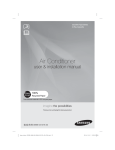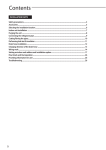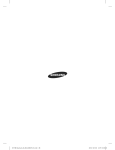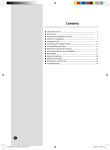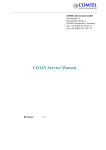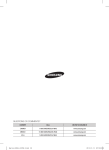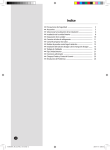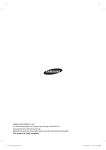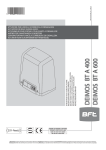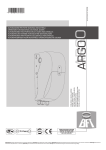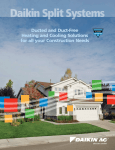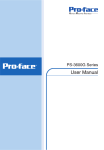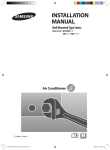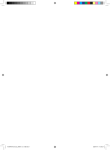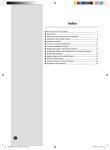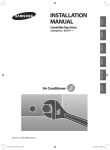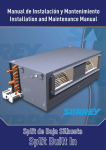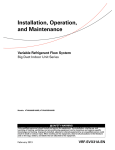Download English pdf
Transcript
Contents
PREPARATION
Safety precautions . . . . . . . . . . . . . . . . . . . . . . . . . . . . . . . . . . . . . . . . . . . . . . . . . . . . . . . . . . . . . . . . . . . . . . . . . . . . . . . . . . . . . . . . . . . . . . . . . . . . . . . . . .3
Accessories . . . . . . . . . . . . . . . . . . . . . . . . . . . . . . . . . . . . . . . . . . . . . . . . . . . . . . . . . . . . . . . . . . . . . . . . . . . . . . . . . . . . . . . . . . . . . . . . . . . . . . . . . . . . . . . . .6
Installation conditions for a fresh duct . . . . . . . . . . . . . . . . . . . . . . . . . . . . . . . . . . . . . . . . . . . . . . . . . . . . . . . . . . . . . . . . . . . . . . . . . . . . . . . . . . . . . . .7
Selecting the Installation Location. . . . . . . . . . . . . . . . . . . . . . . . . . . . . . . . . . . . . . . . . . . . . . . . . . . . . . . . . . . . . . . . . . . . . . . . . . . . . . . . . . . . . . . . . . .8
INSTALLATION
Indoor Unit Installation. . . . . . . . . . . . . . . . . . . . . . . . . . . . . . . . . . . . . . . . . . . . . . . . . . . . . . . . . . . . . . . . . . . . . . . . . . . . . . . . . . . . . . . . . . . . . . . . . . . . 11
Purging the Unit . . . . . . . . . . . . . . . . . . . . . . . . . . . . . . . . . . . . . . . . . . . . . . . . . . . . . . . . . . . . . . . . . . . . . . . . . . . . . . . . . . . . . . . . . . . . . . . . . . . . . . . . . . 12
Connecting the Refrigerant Pipe. . . . . . . . . . . . . . . . . . . . . . . . . . . . . . . . . . . . . . . . . . . . . . . . . . . . . . . . . . . . . . . . . . . . . . . . . . . . . . . . . . . . . . . . . . . 13
Cutting/Flaring the pipes. . . . . . . . . . . . . . . . . . . . . . . . . . . . . . . . . . . . . . . . . . . . . . . . . . . . . . . . . . . . . . . . . . . . . . . . . . . . . . . . . . . . . . . . . . . . . . . . . . 14
Performing Leak Test & Heat Insulation . . . . . . . . . . . . . . . . . . . . . . . . . . . . . . . . . . . . . . . . . . . . . . . . . . . . . . . . . . . . . . . . . . . . . . . . . . . . . . . . . . . . 15
Air Pipe Installation . . . . . . . . . . . . . . . . . . . . . . . . . . . . . . . . . . . . . . . . . . . . . . . . . . . . . . . . . . . . . . . . . . . . . . . . . . . . . . . . . . . . . . . . . . . . . . . . . . . . . . . 18
Drain Pipe and Drain Hose Installation . . . . . . . . . . . . . . . . . . . . . . . . . . . . . . . . . . . . . . . . . . . . . . . . . . . . . . . . . . . . . . . . . . . . . . . . . . . . . . . . . . . . 19
Wiring Work. . . . . . . . . . . . . . . . . . . . . . . . . . . . . . . . . . . . . . . . . . . . . . . . . . . . . . . . . . . . . . . . . . . . . . . . . . . . . . . . . . . . . . . . . . . . . . . . . . . . . . . . . . . . . . . 23
OTHERS
Setting an indoor unit address and installation option . . . . . . . . . . . . . . . . . . . . . . . . . . . . . . . . . . . . . . . . . . . . . . . . . . . . . . . . . . . . . . . . . . . . . 28
Increasing Fan Speed. . . . . . . . . . . . . . . . . . . . . . . . . . . . . . . . . . . . . . . . . . . . . . . . . . . . . . . . . . . . . . . . . . . . . . . . . . . . . . . . . . . . . . . . . . . . . . . . . . . . . . 36
Final Checks and User Tips. . . . . . . . . . . . . . . . . . . . . . . . . . . . . . . . . . . . . . . . . . . . . . . . . . . . . . . . . . . . . . . . . . . . . . . . . . . . . . . . . . . . . . . . . . . . . . . . . 37
Troubleshooting . . . . . . . . . . . . . . . . . . . . . . . . . . . . . . . . . . . . . . . . . . . . . . . . . . . . . . . . . . . . . . . . . . . . . . . . . . . . . . . . . . . . . . . . . . . . . . . . . . . . . . . . . . 38
MEMO . . . . . . . . . . . . . . . . . . . . . . . . . . . . . . . . . . . . . . . . . . . . . . . . . . . . . . . . . . . . . . . . . . . . . . . . . . . . . . . . . . . . . . . . . . . . . . . . . . . . . . . . . . . . . . . . . . . . 39
ENGLISH-2
Safety precautions
Carefully follow the precautions listed below because they are essential to guarantee the safety of the equipment.
fCarefully read the content of this manual before installing the air conditioner and store the manual in a safe place in order
to be able to use it as reference after installation.
fFor maximum safety, installers should always carefully read the following warnings.
fStore the operation and installation manual in a safe location and remember to hand it over to the new owner if the air
conditioner is sold or transferred.
fThis manual explains how to install an indoor unit with a split system with two SAMSUNG units. The use of other types
of units with different control systems may damage the units and invalidate the warranty. The manufacturer shall not be
responsible for damages arising from the use of non compliant units.
fThe manufacturer shall not be responsible for damage originating from unauthorized changes or the improper
connection of electric and requirements set forth in the “Operating limits” table, included in the manual. Making such
changes or improper connections may damage the units and invalidate the warranty.
fThe air conditioner should be used only for the applications for which it has been designed: the indoor unit is not suitable
to be installed in areas used for laundry.
fDo not use the units if damaged. If problems occur, switch the unit off and disconnect it from the power supply.
fIn order to prevent electric shocks, fires or injuries, always stop the unit, disable the protection switch and contact
SAMSUNG’s technical support if the unit produces smoke, if the power cable is hot or damaged or if the unit is very noisy.
fAlways remember to inspect the unit, electric connections, refrigerant tubes and protections regularly. These operations
should be performed by qualified personnel only.
fThe unit contains moving parts, which should always be kept out of the reach of children.
fDo not attempt to repair, move, alter or reinstall the unit. If performed by unauthorized personnel, these operations may
cause electric shocks or fires.
fDo not place containers with liquids or other objects on the unit.
fAll the materials used for the manufacture and packaging of the air conditioner are recyclable.
fThe packing material and exhaust batteries of the remote controller(optional) must be disposed of in accordance with
current laws.
fThe air conditioner contains a refrigerant that has to be disposed of as special waste. At the end of its life cycle, the air
conditioner must be disposed of in authorized centers or returned to the retailer so that it can be disposed of correctly
and safely.
fDo not use the drain pipe or gas (liquid) pipe as a lift point for moving the unit.
ENGLISH-3
PREPARATION
General information
01
WARNING
t Always disconnect the air conditioner from the power supply before servicing it or
accessing its internal components.
t Verify that installation and testing operations are performed by qualified personnel.
t Verify that the air conditioner is not installed in an easily accessible area.
Safety precautions
Installing the unit
IMPORTANT: When installing the unit, always remember to connect first the refrigerant tubes, then the electrical lines. Always
disassemble the electric lines before the refrigerant tubes.
fUpon receipt, inspect the product to verify that it has not been damaged during transport. If the product appears
damaged, DO NOT INSTALL it and immediately report the damage to the carrier or retailer (if the installer or the
authorized technician has collected the material from the retailer.)
fAfter completing the installation, always carry out a functional test and provide the instructions on how to operate the air
conditioner to the user.
fDo not use the air conditioner in environments with hazardous substances or close to equipment that release free flames
to avoid the occurrence of fires, explosions or injuries.
fOur units should be installed in compliance with the spaces shown in the installation manual, to ensure accessibility from
both sides and allow repairs or maintenance operations to be carried out. The unit’s components should be accessible
and easy to disassemble without endangering people and objects.
fFor this reason, when provisions of the installation manual are not complied with, the cost required to access and repair
the units (in SAFETY CONDITIONS, as set out in prevailing regulations) with harnesses, ladders, scaffolding or any other
elevation system will NOT be considered part of the warranty and will be charged to the end customer.
Power supply line, fuse or circuit breaker
fAlways make sure that the power supply is compliant with current safety standards. Always install the air conditioner in
compliance with current local safety standards.
fAlways verify that a suitable grounding connection is available.
fVerify that the voltage and frequency of the power supply comply with the specifications and that the installed power is
sufficient to ensure the operation of any other domestic appliance connected to the same electric lines.
fAlways verify that the cut-off and protection switches are suitably dimensioned.
fVerify that the air conditioner is connected to the power supply in accordance with the instructions provided in the
wiring diagram included in the manual.
fAlways verify that electric connections (cable entry, section of leads, protections…) are compliant with the electric
specifications and with the instructions provided in the wiring scheme. Always verify that all connections comply with
the standards applicable to the installation of air conditioners.
ENGLISH-4
CAUTION
PREPARATION
ENGLISH-5
01
t Make sure that you earth the cables.
- Do not connect the earth wire to the gas pipe, water pipe, lighting rod or telephone wire. If earthing is not
complete, electric shock or fire may occur.
t Install the circuit breaker.
- If the circuit breaker is not installed, electric shock or fire may occur.
t Make sure that the condensed water dripping from the drain hose runs out properly and safely.
t Install the power cable and communication cable of the indoor and outdoor unit at least 1m away from the
electric appliance.
t Install the indoor unit away from lighting apparatus using the ballast.
- If you use the wireless remote control, reception error may occur due to the ballast of the lighting apparatus.
t Do not install the air conditioner in following places.
- Place where there is mineral oil or arsenic acid. Resin parts flame and the accessories may drop or water may
leak. The capacity of the heat exchanger may reduce or the air conditioner may be out of order.
- The place where corrosive gas such as sulfurous acid gas generates from the vent pipe or air outlet.
- The copper pipe or connection pipe may corrode and refrigerant may leak.
- The place where there is a machine that generates electromagnetic waves. The air conditioner may not
operate normally due to control system.
- The place where there is a danger of existing combustible gas, carbon fiber or flammable dust.
- The place where thinner or gasoline is handled. Gas may leak and it may cause fire.
Accessories
fThe following accessories are supplied with the indoor unit.
fThe type may differ depending on the specifications and it is subject to the actual type.
User manual (1)
Installation manual (1)
Clamp hose (1)
Flexible hose (1)
Insulation drain (1)
Thermal insulation
sponge A (1)
Thermal insulation
sponge B (1)
Thermal insulation
sponge C (1)
Cable-tie (8)
Rubber (8)
ENGLISH-6
Installation conditions for a fresh duct
Installation information on a fresh duct
- Fresh duct 8ton(96kBtu/h) + Fresh duct 6ton(72kBtu/h) = 168kBtu/h
Outdoor unit 14ton(168kBtu/h) = 168kBtu/h
Fresh duct combination rate = 100% l O.K
Indoor unit combination rate = 0% l O.K
Only Fresh Air Intake Unit install
Outdoor : 168 kBtu/h
Fresh
Fresh
Duct
Duct
96kBtu/h 72kBtu/h
ENGLISH-7
PREPARATION
Fresh
Duct Standard Standard Standard Standard Standard Standard Standard Standard Standard
72kBtu/h 18kBtu/h 18kBtu/h 18kBtu/h 18kBtu/h 18kBtu/h 18kBtu/h 18kBtu/h 18kBtu/h 18kBtu/h
01
fA fresh duct can be installed wiith an indoor unit or with another fresh duct.
fA fresh duct should be installed within 50%~100% of outdoor unit's cooling capacity.
fIf a fresh duct is installed with an indoor unit, the fresh duct should be installed within 30% of outdoor unit's cooling
capacity.
fA fresh duct can be installed with HEAT PUMP outdoor unit but cannot be installed with HEAT RECOVERY outdoor unit.
- e.g. A fresh duct 6ton(72kBtu/h) + Duct 18kBtu/h x 9 = 234kBtu/h
Outdoor unit 6ton(72kBtu/h) + 14ton(168kBtu/h) = 240kBtu/h
Indoor unit combination rate = 97.5% l O.K
Fresh duct combination rate = 30% l O.K
Mixture Install
Outdoor : 240 kBtu/h
Selecting the Installation Location
Indoor unit
fThere must be no obstacles near the air inlet and outlet.
fInstall and mount the indoor unit on a ceiling that can support its weight.
fMaintain sufficient clearance around the indoor unit.
fMake sure that the water drains from the hose properly and safely.
fThe indoor unit must be installed in such way that it is out of commonly accessible area. (Not touchable by the users.)
fDurable walls which can’t be shaken.
fWhere it is not exposed to direct sunshine.
fWhere the air filter can be removed and cleaned easily.
fCautions on installation
1) Do not install in crowded places. Please install in equipment spaces such as mechanical rooms and adopt measures
to prevent noise and vibration.
2) Adopt preventative measures to accommodate noise and vibration according to the ceiling installation condition
(washroom, corridor).
3) Separate air outlet shall be installed for the Fresh duct. Do not connect with the inlet of other indoor units, otherwise,
the performance of air conditioner will be affected.
4) Please purchase damper to adjust air volume and filter screen for installation.
CAUTION
t In principle, the unit should not be installed at an height of lower than 8.2ft (2.5m) from the ground.
t If the unit has proper pipe (11.8inch (300mm) in length or more) to avoid contact with the fan motor blower, it is
possible to install the unit at a height of between 7.2~8.2ft (2.2~2.5m) from the ground.
t If the humidity is over 80%, it is required to add 10mm polyethylene foam or other similar insulation to the
indoor unit when installing belt or pipe type indoor unit on the ceiling.
Insulation Guide
#
%
Back
Front
"
$
Thickness: more than 0.39inch (10mm)
Indoor Unit
AM072JNESCH
AM096JNESCH
A
B
C
D
Front / Back
Insulate the front and back side in
57.68"×33.86"×18.11" 53.54"×18.11" 53.54"×18.11" 33.86"×18.11" 33.86"×18.11" proper size at the same time when
(1465×860×460)
(1360×460)
(1360×460)
(860×460)
(860×460) insulating the suction duct and
discharge duct.
fInsulate the end of the pipe and some curved area by using separate insulator.
fInsulate the discharge and suction part at the same time when you insulate connection duct.
fIf the humidity is over 80%, it is required to add 0.39inch(10mm) polyethylene foam or other similar insulation to the
indoor unit when installing belt or pipe type indoor unit on the ceiling.
ENGLISH-8
Space requirements for indoor unit
01
fConstruction Standard for Inspection Hole.
5) In case the ceiling is textile, inspection hole is not necessary.
6) In case the ceiling is plaster board, inspection hole depends on the inside height of the ceiling.
a. Height is more than 1.64ft (0.5m) : Only “B” [Inspection for PBA] is applied.
b. Height is less than 1.64ft (0.5m) : Both “A” & ”B” are applied.
c. “A” & ”B” are inspection holes.
Depth (D)
PREPARATION
Width (W)
“A”=W+3.94inch (100mm)
“B”=19.7inch (500mm)
0.79inch (20mm)
or more
0.79inch (20mm)
or more
t You must have 0.79inch (20mm) or more space between the ceiling and the bottom of indoor unit. Otherwise, the
noise from the vibration of indoor unit may bother the user.
t When the ceiling is under construction, the inspection hole must be made to enable servicing, maintenance and
cleaning.
t The indoor unit should be installed at a height of 8.2ft (2.5m) and/or above ground.
ENGLISH-9
Selecting the Installation Location
AM072JNESCH / AM096JNESCH
Unit : inch(mm)
50.55(1284) Suction flange
47.2(50x24=1200)
7
33.86(860.0)
30.79(782.0) Suspension position
6
3
Suction side
No.
Name
1
Diameter of liquid pipe
4
Discharge side
Description
ø9.52 (3/8”)
2
Diameter of air pipe
3
Diameter of drain pipe
Diameter of drain pipe (Optional drain pump)
4
Power supply / Communication connection
5
Air discharge grille flange
6
Suction flange
7
Hook
AM072JNESCH : ø19.05 (3/4”)
AM096JNESCH : ø22.22 (7/8”)
VP25 (OD ø32 (1.26"), ID ø25 (0.98"))
VP25 (OD ø32 (1.26"), ID ø25 (0.98"))
ø9.52 (3/8”) or M10
ENGLISH-10
18.11(460.0)
2
14.17(360.0)
1
11.81(50x6=300)
1.38(35.0)
8.93(226.7)
11.17(283.7)
14.17(360.0)
11.81(50x6=300)
5
47.2(50x24=1200)
50.55(1284) Air discharge grille flange
53.54(1360.0)
54.80(1392) Suspension position
Indoor Unit Installation
When deciding on the location of the air conditioner with the owner, the following restrictions must be taken into account.
1. Place the pattern sheet on the ceiling at the spot where you want to
install the indoor unit.
01
t Since the diagram is made of paper, it may shrink or stretch
slightly due to temperature or humidity. For this reason, before
drilling the holes maintain the correct dimensions between the
markings.
Concrete
2. Insert bolt anchors. Use existing ceiling supports or construct a suitable
support as shown in figure.
3. Install the suspension bolts depending on the ceiling type.
CAUTION
t Ensure that the ceiling is strong enough to support the weight
of the indoor unit. Before hanging the unit, test the strength of
each attached suspension bolt.
t If the length of suspension bolt is more than 4.92ft (1.5m),
it is required to prevent vibration.
t If this is not possible, create an opening on the false ceiling in
order to be able to use it to perform the required operations on
the indoor unit.
PREPARATION
NOTE
Insert
Hole in anchor
hole in plug
Suspension bolt(ø9.52 (3/8”) or M10)-field supply
Ceiling support
4. Screw eight nuts to the suspension bolts making space for hanging the
indoor unit.
NOTE
t You must install all the suspension rods.
5. Hang the indoor unit to the suspension bolts between two nuts.
CAUTION
t Piping must be laid and connected inside the ceiling when
suspending the unit. If the ceiling is already constructed, lay the
piping into position for connection to the unit before
placing the unit inside the ceiling.
6. Screw the nuts to suspend the unit.
7. Adjust level of the unit by using measurement plate for all 4 sides.
CAUTION
t For proper drainage of condensate, give a 0.12inch (3mm) slant
to the left or right side of the unit which will be connected with
the drain hose, as shown in the figure. Make a tilt when you
wish to install the drain pump, too.
t t8IFOJOTUBMMJOHUIFJOEPPSVOJUNBLFTVSFJUJTOPUUJMUFE
toward front or back side.
When drain hose is installed on the right side.
0.12inch
(3mm)
ENGLISH-11
Drain hose port
Purging the Unit
On delivery, the indoor unit is loaded with inert gas. All this gas must therefore be purged before connecting the assembly
piping. To purge the inert gas, proceed as follows.
Unscrew the pinch pipe at the end of each refrigerant unit.
Result : All inert gas escapes from the indoor unit.
NOTE
t Since the diagram is made of paper, it may shrink or stretch
slightly due to temperature or humidity. For this reason,
maintain the correct measurements between the markings
before drilling the holes.
Torque
wrench
Spanner
Flare nut
Union
In order to perform leak check, the product has been filled with nitrogen.
Discharge all the nitrogen before installation.
The liquid pipe and air pipe are connected by nuts and are welded,
respectively. Unscrew the nuts of liquid pipe to clear the nitrogen and then
disconnect the air pipe with welding flame.
CAUTION
t Welding without unscrewing the nuts of liquid pipe and while
there is nitrogen present will result in explosion.
t Leak may occur when there is no nitrogen present after
unscrewing the liquid pipe.
t Before installation, be sure to perform leak check.
❋ The design and shape are subject to change
according to the model.
ENGLISH-12
Connecting the Refrigerant Pipe
6.35
1/4
LHGtDN
Torque
/tN
MCGtGU
140~180
14~18
10.3~13.3
9.52
3/8
350~430
34~42
25.1~31.0
12.70
1/2
500~620
49~61
36.1~45.0
15.88
5/8
690~830
68~82
50.2~60.5
NOTE
Torque
wrench
Spanner
Flare nut
Union
t Must apply refrigerant oil on the flaring area to prevent a leak.
2. Be sure that there must be no crak or kink on the bended area.
AM072JNESCH / AM096JNESCH
A
Wet towel
Liquid pipe
Gas pipe
Welding flame
Drain hose port
❋ Before connection, unscrew the nuts of liquid pipe first.
- Product is filled with nitrogen.
Model
Liquid pipe
Gas pipe
Description
AM072JNESCH
Ø9.52 (3/8")
Ø19.05 (3/4")
Gas pipe: Welded
AM096JNESCH
Ø9.52 (3/8")
Ø22.22 (7/8")
Gas pipe: Welded
ENGLISH-13
INSTALLATION
Outer Diameter
mm
inch
Refrigerant oil
02
There are two refrigerant pipes of different diameters:
fA smaller one for the liquid refrigerant
fA larger one for the gas refrigerant
fThe inside of copper pipe must be clean and has no dust.
The connection procedure for the refrigerant pipes varies according to the
exit position of the pipes from the indoor unit, as seen when facing the
indoor in the "A" side.
fLiquid refrigerant port
fGas refrigerant port
fDrain hose port
1. Remove the pinch pipe on the pipes, connect the assembly pipes to
each pipe and tighten the nuts. First tighten the nuts manually and
then with a torque wrench applying the following torque.
Connecting the Refrigerant Pipe
Welding copper pipe
fMake sure that there is no moisture inside the pipe.
fMake sure that there is no foreign substance inside the pipe.
fMake sure that there is no leakage.
fMake sure to follow the instruction while welding the copper pipe.
Fill nitrogen
1. Use nitrogen while welding the copper pipe, as shown in the figure.
2. If nitrogen is not used while welding the copper pipe, oxidation may
be produced inside the pipe, causing damage to the compressor and
valve.
3. Use pressure gage to adjust the filling speed and keep it within
0.05m3/h.
Brazed part
Nitrogen
Pressure
gage
Pipe direction upon welding of copper pipe
Place the marked side downward or on the level position while welding the copper pipe.
Downward
NOTE
Side
Upward
t Avoid welding pipe upward.
ENGLISH-14
Wrap with belt
Stop valve
ø6.35 (1/4") Copper pipe
Flow meter
Cutting/Flaring the pipes
1. Make sure that you prepare the required tools (pipe cutter, reamer, flaring tool and pipe holder).
2. If you want to change the length of pipe, cut it using a pipe cutter ensuring that the cut edge remains at a right angle
with the side of the pipe. There are some examples of correctly and incorrectly cut edges below.
Oblique
Rough
Burr
02
90°
INSTALLATION
3. To prevent a gas leak, remove all burrs at the cut edge of the pipe using a reamer.
4. Carry out flaring work using flaring tool as shown below.
A
Flaring tool
Yoke
Die
Die
Clutch type
Wing nut type
Copper pipe
Copper pipe
Outer Diameter
(D)
Flare nut
A
Conventional flare tool
Clutch type
Wing nut type
R-410A Flare tool for
clutch type
mm
inch
mm
inch
mm
inch
mm
inch
6.35
1/4
0~0.5
0~0.02
1.0~1.5
0.04~0.06
1.5~2.0
0.06~0.08
9.52
3/8
0~0.5
0~0.02
1.0~1.5
0.04~0.06
1.5~2.0
0.06~0.08
12.70
1/2
0~0.5
0~0.02
1.0~1.5
0.04~0.06
1.5~2.0
0.06~0.08
15.88
5/8
0~0.5
0~0.02
1.0~1.5
0.04~0.06
1.5~2.0
0.06~0.08
5. Check if you flared the pipe correctly. There are some examples of incorrectly flared pipes below.
Correct
Inclined
Damaged
Surface
Cracked
Uneven
Thickness
6. Align the pipes and tighten the flare nuts first manually and then with a torque wrench, applying the following torque.
Outer diameter
Torque
Flare dimension
LHGtDN
/tN
Ibf·ft
mm
inch
8.70~9.10
0.34~0.36
6.35
1/4
140~180 14~18 10.3~13.3
9.52
3/8
350~430 34~42 25.1~31.0 12.80~13.20 0.50~0.52
12.70
1/2
500~620 49~61 36.1~45.0 16.20~16.60 0.64~0.65
15.88
5/8
690~830 68~82 50.2~60.5 19.30~19.70 0.76~0.78
t In case of needing brazing, you must work with Nitrogen gas blowing.
CAUTION
ENGLISH-15
45° ±2°
inch
90° ±2°
Flare shape
mm
R 0.4~0.8
(0.016"~0.032")
Performing Leak Test & Heat Insulation
Leak test
In order to detect gas leak from the indoor unit, use nitrogen to check the
connection areas of the refrigerant pipes.
NOTE
t Please refer to the leak test in the installation manual for the
outdoor unit.
Leak test
❋ The design and shape are subject to change
according to the model.
Insulation
1. Insulate the refrigerant pipe.
fMake sure to insulate the refrigerant pipe, connector and connection
area.
- If the pipes are insulated, condensation will not come out from the
piping and the capacity of Fresh duct will be increased.
fCheck for cracks in the insulation cover pipe out at the bended area.
Pipe clamp
Insulation
material
Insulation pipe
sleeve
Gas side pipe
Liquid side pipe
Insulation material
Indoor unit
Insulation material should be
overlapped.
Fix without loosing
ENGLISH-16
2. Select the insulation of refrigerant pipe.
fInsulate the gas side and liquid side pipe referring to the thickness according to the pipe size.
fIndoor temperature of 30°C (86°F) and humidity of 85% is the standard condition. If installing in a high humidity
condition, use one grade thicker insulator by referring to the table below. If installing in an unfavorable condition, use
thicker insulator.
fInsulation's heat-resistance temperature should be more than 120°C (248°F).
02
Installation type (Heating/Cooling)
Standard [30°C (86°F),85%] High humidity [30°C (86°F), over 85%]
Pipe
EPDM, NBR
mm
inch
Liquid Ø6.35 ~ Ø9.52 1/4~3/8
pipe Ø12.7 ~ Ø50.80 1/2~2
Ø6.35
Gas
pipe
CAUTION
1/4
Ø9.52
3/8
Ø12.70
1/2
Ø15.88
5/8
Ø19.05
3/4
Ø22.23
7/8
Ø25.40
1
Ø28.58
9/8
Ø31.75
5/4
Ø38.10
3/2
Ø44.45
7/4
Ø50.80
2
mm
inch
mm
inch
9t
3/8
9t
3/8
13t
1/2
13t
1/2
13t
1/2
19t
3/4
25t
1
32t
5/4
38t
3/2
19t
25t
3/4
1
Remarks
Internal temperature
is higher than 120°C
(248°F)
t The insulation must be installed diligently and the adhesives should be used on the connecting part to prevent
moisture from entering.
t Wind the refrigerant pipe with insulation tape if it is exposed to outside sunlight.
t Insulation mustn’t become thinner at the bent part or the hanging area of the refrigerant pipe.
t Add the additional insulation if the insulation plate gets thinner.
Hanger
Additional insulation
a
a×3
Refrigerant pipe insulation
ENGLISH-17
INSTALLATION
Pipe size
Air Pipe Installation
1. Use hose (provided on site) to connect the adapter at the suction/discharge side.
Please use aluminum-foil paper to seal the connection area of air pipe to avoid gas leak.
t For installation, tilt the suction side of air pipe to avoid water accumulation.
CAUTION
2. Insulate the air pipe to avoid condensation.
Insulation cover pipe out
(Please insulate with aluminum tape)
Outdoor suction air pipe
Gradient
(1/100~1/50)
CAUTION
Filter
Aluminum-foil paper Aluminum-foil paper
t Filter must be installed at the air inlet. Buy filter with a dust collection efficiency of over 50% (standard of weight
method) and install.
t If the sealing material is not tidy or tight, abnormal situation may occur during operation.
Connection method of external load
1. Damper can be installed if necessary when connecting to the Fresh
duct.
2. Install damper from outside and the damper will work with the Fresh
duct.
Wiring terminal
L1
L1 Power
L2 Power
Option
ENGLISH-18
Damper
(0.5A)
L2
Drain Pipe and Drain Hose Installation
Care must be taken when installing the drain hose for the indoor unit to ensure that any condensation is correctly drained
outside. The drain hose can be installed to the left or right side of the base pan.
1. Install the drain hose as short as possible.
Metal clamp
Drain socket
Drain hose
Cable tie
Drain piping
""
Large sealing pad
2. When there is no draining pump, insulate the drain hose and then fix it
as a picture.
NOTE
t Insert the drain hose to bottom of the outfall of water basin.
t Lock steel ring of the drain hose according to the figure.
t Wind and wrap steel ring and drain hose fully with thermal
insulation sponge; fix both ends of external layer with ribbon
for thermal insulation.
t After being installed, drain hose must be insulated fully by heat
insulating material.(To be provided at site.)
3. While using draining pump, insulate the drain hose with heat insulating
material according to the figure.
NOTE
t Check if the rubber ring is installed properly on the draining
pump.
t Check if the drain cap blocks the outfall of drain pan properly.
ENGLISH-19
Tighten the clamp to the maximum.
INSTALLATION
Indoor
unit
02
NOTE
t In order to discharge condensation water, the drain hose
should keep tilted.
t Secure the drain hose with the cable-tie not to be separated
from the unit.
t The drain pump connection port is used when using a drain
pump.
Drain Pipe and Drain Hose Installation
Connecting Drain Pipe
Without the drain pump
1. Install horizontal drain pipe with a slope of 1/100 or more and fix it by hanger space of 3.28~4.92ft (1.0~1.5m).
2. Install U-trap at the end of the drain pipe to prevent odor to reach the indoor unit.
3. The drain pipe should not be installed at an upward position; it may cause water flowing back to the unit.
3.28~4.92ft
(1~1.5m)
Hanger
H≥1.97"
(50mm)
1H
2
Flexible hose
Horizontal drain pipe
(Slope above 1/100)
Ceiling
With the drain pump
1. The drain pipe should be installed within 11.81inch(300mm) to 21.65inch(550mm) from the flexible hose and then lift
down 0.79inch(20mm) or more.
2. Install horizontal drain pipe with a slope of 1/100 or more and fix it by hanger space of 3.28~4.92ft (1.0~1.5m).
3. Install the air vent in the horizontal drain pipe to prevent water flow back to the indoor unit.
NOTE
t You may not need to install it if there were proper slope in the horizontal drain pipe.
4. The flexible hose should not be installed at an upward position; it may cause water flowing back to the indoor unit.
Air vent
11.81inch(300mm)
or less
3.28~4.92ft
7.87inch
(1~1.5m)
(200mm)
or more
0.79inch
(20mm) or more
Hanger
Within
11.81~21.65inch
(300~550mm)
Flexible hose
Ceiling
Horizontal drain pipe
(Slope above 1/100)
ENGLISH-20
Centralized drainage
Without the drain pump
INSTALLATION
3.94inch
(100mm)
or more
Horizontal drain pipe
(Slope above 1/100)
Ceiling
With the drain pump
1. Install main air vent at the front of the farthest indoor unit from the main drain pipe when installed indoor units are more
than 3.
2. You may need to install individual air vent to prevent water flow back at the top of each indoor unit drain pipe.
3.28~4.92ft
(1~1.5m) Main air vent
Hanger
Individual
air vent
21.65inch
(550mm) or less
Main drain pipe
Centralized horizontal drain
pipe (Slope above 1/100)
ENGLISH-21
02
1. Install horizontal drain pipe with a slope of 1/100 or more and fix it by hanger space of 3.28~4.92ft (1~1.5m).
2. Install U-trap at the end of the drain pipe to prevent odor to reach the indoor unit.
3. The drain pipe should not be installed at an upward position; it may cause water flowing back to the unit.
Drain Pipe and Drain Hose Installation
Testing the drainage
After installation, test the drainage. Prepare about 2 liters of water.
1. Unscrew the screws of pipe cover and remove the cover.
2. Pour water into the indoor unit as shown in the figure.
NOTE
t Please refer to the leak test in the installation manual for the
outdoor unit.
3. Confirm that the water flows out through the drain hose.
4. When the drain pump is installed, operate the unit in cooling mode and
check the pumping operation of the drain pump.
5. Check the water drops draining at the end of the drain pipe.
Water supply intake
Drain pipe
Drain water drops
6. Make sure there is no water leak at the drainage.
7. Reassemble the cover of water supply intake.
❋ The design and shape are subject to change
according to the model.
ENGLISH-22
Wiring Work
Power and communication cable connection
ELB: earth leakage protection
ELCB: overcurrent protection + earth leakage protection
3. The power cable should only use copper wires.
4. Connect the power cable {1(L), 2(N)} among the units and communication cables (F1, F2). The maximum length of cables
shall be 3281ft (1000m).
5. When installing the wired remote control, connect F3 and F4 (for communication).
(Indoor PBA will be damaged if V1, V2, F3, F4 are shorted out.)
6. Installation conditions for a wired remote controller
fA fresh duct and an indoor unit should not be installed by one wired remote controller.
fThe fresh duct has a different operation mode, temperature setting, etc. Therefore, if the fresh duct and an indoor unit are
installed by one wired remote controller, a problem may occur.
fInstallation between fresh ducts can be controlled by one wired remote controller.
Example of correct installation
Installation between fresh ducts
Outdoor unit
or
208V - 230V
ELCB
ELB
Wired remote controller
MCCB
L1
L2
L1
Fresh Duct 1
L2
L1
L2
Fresh Duct 2
Fresh Duct 3
❋ ELCB : Essential installation.
t Power off before connecting any wire. Indoor PBA will be damaged if V1, V2, F3, F4 are shorted out.
WARNING
NOTE
t Installation between fresh ducts can be controlled by one wired remote controller.
ENGLISH-23
INSTALLATION
MCCB: overcurrent protection
02
1. Before wiring work, you must turn off all power source.
2. Indoor unit power should be supplied through the breaker (MCCB: Molded Case Circuit Breaker, ELB: Earth Leakage
Breaker, ELCB: Earth Leakage Circuit Breaker) separated by the outdoor power.
Wiring Work
Outdoor unit
or
208V - 230V
ELCB
ELB
Wired remote controller
Wired remote controller
MCCB
L1
L2
L1
L2
Indoor unit 1
L1
L2
Indoor unit 2
Fresh Duct 1
❋ ELCB : Essential installation.
t Power off before connecting any wire. Indoor PBA will be damaged if V1, V2, F3, F4 are shorted out.
WARNING
NOTE
t If indoor units are mixed with fresh ducts, they should not be controlled by one wired remote controller.
Example of incorrect installation
Installation between a fresh duct and an indoor unit
Outdoor unit
or
ELCB
Wired remote controller
208V - 230V
ELB
MCCB
L1
L2
L1
Indoor unit 1
L2
L1
Indoor unit 2
L2
Fresh Duct 1
❋ ELCB : Essential installation.
t Power off before connecting any wire. Indoor PBA will be damaged if V1, V2, F3, F4 are shorted out.
WARNING
NOTE
t If indoor units mixed with fresh ducts are controlled by one wired remote controller, a problem may occur due to
different operation specification.
ENGLISH-24
Selecting compressed ring terminal
Silver solder
02
0.0023 (1.5)
Norminal dimensions for screw [inch (mm)]
Standard dimension [inch (mm)]
B
0.0062 (4)
0.16 (4)
0.16 (4)
0.16 (4)
0.16 (4)
0.26 (6.6)
0.31 (8)
0.26 (6.6)
0.33 (8.5)
0.37 (9.5)
Allowance [inch (mm)]
±0.0079 (±0.2)
±0.0079 (±0.2)
±0.0079 (±0.2)
Standard dimension [inch (mm)]
Standard dimension [inch (mm)]
0.13 (3.4)
+0.012 (+0.3)
-0.0079 (-0.2)
0.067 (1.7)
0.17 (4.2)
+0.012 (+0.3)
-0.0079 (-0.2)
0.091 (2.3)
0.22 (5.6)
+0.012 (+0.3)
-0.0079 (-0.2)
0.134 (3.4)
D
Allowance [inch (mm)]
d1
0.0039 (2.5)
0.16 (4)
Allowance [inch (mm)]
±0.0079 (±0.2)
±0.0079 (±0.2)
±0.0079 (±0.2)
E
Min. [inch (mm)]
0.16 (4.1)
0.24 (6)
0.24 (6)
F
Min. [inch (mm)]
0.24 (6)
0.24 (6)
0.20 (5)
L
Max. [inch (mm)]
0.63 (16)
0.69 (17.5)
0.79 (20)
Standard dimension [inch (mm)]
0.17 (4.3)
+0.0079 (+0.2)
0 (0)
0.028 (0.7)
0.17 (4.3)
+0.0079 (+0.2)
0 (0)
0.031 (0.8)
0.17 (4.3)
+0.0079 (+0.2)
0 (0)
0.035 (0.9)
d2
Allowance [inch (mm)]
t
Min. [inch (mm)]
Specification of electric wire
Power supply
Max.: 253V
Min.: 187.2V
MCCB
ELB or ELCB
Power cable
Earth cable
Communication cable
XA
XA, 30mmA
0.1 s
0.0039inch2
(2.5mm2)
0.0039inch2
(2.5mm2)
0.0012~0.0023inch2
(0.75~1.5mm2)
❋ Rating current
Unit
AM✴✴✴JNESCH✴✴✴
Model
Rating current
Remarks
✴✴072✴✴
2.6A
-
✴✴096✴✴
3.1A
-
fDecide the capacity of ELCB or MCCB and ELB by the following formula.
The capacity of ELCB or MCCB and ELB X[A] = 1.25 X 1.1 X ∑Ai
❋ X : The capacity of ELCB or MCCB and ELB
❋ ∑Ai : Sum of rating currents of each indoor unit.
❋ Refer to each installation manual about the rating current of indoor unit.
ENGLISH-25
INSTALLATION
Norminal dimensions for cable [inch2 (mm2)]
Wiring Work
fDecide the power cable specification and maximum length within 10% power drop among the indoor units.
n
Coef×35.6×Lk×ik
∑(
) < 10% of input voltage[V]
1000×Ak
k=1
❋ coef: 1.55
❋ Lk: Distance among each unit [m], Ak: Power cable specification [mm2]
ik: Running current of each unit [A]
Example of Installation
- Total power cable length L = 328ft (100m), Running current of each units 1[A]
- Total 10 indoor units were installed
9[A]
10[A]
ELB
1[A]
MCCB
Indoor unit 1
32.8ft (10m)
0ft (0m)
Indoor unit 2
Indoor unit 10
328ft (100m)
65.6ft 20(m)
fUse the following formula
n
∑(
k=1
Coef×35.6×Lk×ik
) < 10% of input voltage [V]
1000×Ak
❋ Calculation
t Installing with 1 sort wire.
0.0039inch2 (2.5mm2)
-2.2[V]
220[V]
0.0039inch2 (2.5mm2)
············ 0.0039inch2 (2.5mm2) ············
-2.0[V]
-(2.2+2.0+1.8+1.5+1.3+1.1+0.9+0.7+0.4+0.2)=-11.2[V]
208.8[V] (Within 198V~242V)
It's okay
t Installing with 2 different sort wire.
0.0062inch2(4.0mm2)
-1.4[V]
220[V]
0.0062inch2(4.0mm2)
············ 0.0039inch2 (2.5mm2) ············
-1.2[V]
-(1.4+1.2+1.8+1.5+1.3+1.1+0.9+0.7+0.4+0.2)=-10.5[V]
ENGLISH-26
209.5[V] (Within 198V~242V)
It's okay
CAUTION
WARNING
_LHGtDN
_/tN
0.89~1.3 lbf·ft
t In case of extending the electric wire, please DO NOT use a round-shaped pressing socket.
- Incomplete wire connections can cause electric shock or a fire.
ENGLISH-27
INSTALLATION
Tightening torque
M4
02
t Select the power cable in accordance with relevant local and national regulations.
t Wire size must comply with local and national code.
t Power Supply cords of parts of appliances for outdoor use shall not be lighter than polychloroprene sheathed
flexible cord. (Code designation IEC:60245 IEC 57 / CENELEC: H05RN-F or IEC:60245 IEC 66/ CENELEC: H07RN-F)
t You should connect the power cable into the power cable terminal and fasten it with a clamp.
t The unbalanced power must be maintained within 10% of supply rating among all indoor units.
t If the power is significantly unbalanced, it may shorten the life of the condenser. If the unbalanced power exceeds
10% of power rating, the indoor unit will stop operation due to its built-in protection and display an error code.
t To protect the product from water and possible shock, you should properly protect the power cable and the
maintain the connection cord of the indoor and outdoor units in good protection.
t Connect the power cable to the auxiliary circuit breaker. All disconnection points from the power supply must be
jointed as one single wire and its length should be over 0.12inch (3mm).
t You must keep the cable in a protection tube.
t Keep distances of 1.97inch (50mm) or more between power cable and communication cable.
t The maximum length of power cables are decided within 10% of power drop. If it exceeds, you must consider
another power supplying method.
t The circuit breaker (MCCB or ELCB) should be considered more capacity if many indoor units are connected from
one circuit breaker.
t Use round pressure terminal for connections to the power terminal block.
t For wiring, use the designated power cable and connect it firmly, then secure it to prevent outside pressure being
exerted on the terminal board.
t Use an appropriate screwdriver for tightening the terminal screws. A screwdriver with a small head will strip the
head and make proper tightening impossible.
t Over-tightening the terminal screws may break them.
t See the table below for tightening torque for the terminal screws.
Setting an indoor unit address and installation option
Set the indoor unit address and installation option with remote controller option.
Set the each option separately since you cannot set the ADDRESS setting and indoor unit installation setting
option at the same time. You need to set twice when setting indoor unit address and installation option.
The procedure of option setting
Air flow direction (Up and down)
Adusts the air flow direction up and down
(Not applicable to Duct type models).
Power
Turns the air conditioner on or off.
Mode
Selects operation mode.
Temperature
Adjusts the temperature.
Fan speed
Adjusts the fan speed.
Options
Selects options during operation.
Air flow direction (Left and right)
Adjusts the air flow direction left and right.
Timer
Sets timer option.
Settings
Selects settings.
SET
Selects or cancels an option.
Direction
Moves to select and set an option.
Step 1. Entering mode to set option
1. Remove batteries from the remote controller.
2. Insert batteries and enter the option setting mode while pressing High Temp button and Low Temp button.
Auto
3.
Check if you have entered the option setting status.
On
Step 2. The procedure of option setting
After entering the option setting status, select the option as listed below.
CAUTION
t 0QUJPOTFUUJOHJTBWBJMBCMFGSPN4&(UP4&(
t 4&(4&(4&(4&(BSFOPUTFUBTQBHFPQUJPO
t 4FUUIF4&(_4&(4&(_4&(BT0/TUBUVTBOE4&(_4&(_BT0''TUBUVT
SEG1 SEG2 SEG3 SEG4 SEG5 SEG6 SEG7 SEG8 SEG9 SEG10 SEG11 SEG12
0
X
X
X
X
X
1
X
X
X
X
X
SEG13 SEG14 SEG15 SEG16 SEG17 SEG18 SEG19 SEG20 SEG21 SEG22 SEG23 SEG24
2
X
X
X
X
X
3
X
X
X
ENGLISH-28
X
X
On(SEG1~12)
Auto
On
Off(SEG13~24)
Auto
Off
0QUJPOTFUUJOH
1. Setting SEG2, SEG3 option
Press Low Fan button(∨) to enter SEG2 value.
Press High Fan button(∧) to enter SEG3 value.
Each time you press the button,
…
4UBUVT
Auto
Auto
On
On
SEG2
will be selected in rotation.
SEG3
Cool
Press Mode button to be changed to Cool mode in the ON status.
On
OTHERS
3. Setting SEG4, SEG5 option
Press Low Fan button(∨) to enter SEG4 value.
Press High Fan button(∧) to enter SEG5 value.
Each time you press the button,
…
03
2. Setting Cool mode
Cool
Cool
On
On
will be selected in rotation.
SEG5
SEG4
Dry
4. Setting Dry mode
On
Press Mode button to be changed to DRY mode in the ON status.
5. Setting SEG6, SEG8 option
Press Low Fan button(∨) to enter SEG6 value.
Press High Fan button(∧) to enter SEG8 value.
Each time you press the button,
…
Dry
will be selected in rotation.
On
SEG8
SEG6
6. Setting Fan mode
Fan
On
Press Mode button to be changed to FAN mode in the ON status.
7. Setting SEG9, SEG10 option
Press Low Fan button(∨) to enter SEG9 value.
Press High Fan button(∧) to enter SEG10 value.
…
Each time you press the button,
Dry
On
Fan
Fan
On
On
will be selected in rotation.
SEG10
SEG9
8. Setting Heat mode
Heat
On
Press Mode button to be changed to HEAT mode in the ON status.
9. Setting SEG11, SEG12 option
Press Low Fan button(∨) to enter SEG11 value.
Press High Fan button(∧) to enter SEG12 value.
Each time you press the button,
…
Heat
will be selected in rotation.
On
SEG12
SEG11
Auto
10. Setting Auto mode
Off
Press Mode button to be changed to AUTO mode in the OFF status.
11. Setting SEG14, SEG15 option
Press Low Fan button(∨) to enter SEG14 value.
Press High Fan button(∧) to enter SEG15 value.
Each time you press the button,
…
Heat
On
will be selected in rotation.
ENGLISH-29
Auto
Auto
Off
On
Off
SEG14
SEG15
Setting an indoor unit address and installation option
0QUJPOTFUUJOH
4UBUVT
12. Setting Cool mode
Cool
Press Mode button to be change to Cool mode in the OFF status.
13. Setting SEG16, SEG17 option
Press Low Fan button(∨) to enter SEG16 value.
Press High Fan button(∧) to enter SEG17 value.
Each time you press the button,
…
Off
Cool
Cool
Off
will be selected in rotation.
Off
SEG16
SEG17
Dry
14. Setting Dry mode
Off
Press Mode button to be change to Dry mode in the OFF status.
15. Setting SEG18, SEG20 option
Press Low Fan button(∨) to enter SEG18 value.
Press High Fan button(∧) to enter SEG20 value.
Each time you press the button,
…
Dry
Dry
Off
will be selected in rotation.
Off
SEG18
16. Setting Fan mode
SEG20
Fan
Off
Press Mode button to be change to Fan mode in the OFF status.
17. Setting SEG21, SEG22 option
Press Low Fan button(∨) to enter SEG21 value.
Press High Fan button(∧) to enter SEG22 value.
Each time you press the button,
…
Fan
Fan
Off
Off
will be selected in rotation.
SEG21
18. Setting Heat mode
SEG22
Heat
Off
Press Mode button to be change to HEAT mode in the OFF status.
19. Setting SEG23, SEG24 mode
Press Low Fan button(∨) to enter SEG23 value.
Press High Fan button(∧) to enter SEG24 value.
Each time you press the button,
…
Heat
will be selected in rotation.
Heat
Off
Off
SEG23
SEG24
Step 3. Check the option you have set
After setting option, press
Auto
On
¤
Dry
¤
On
Auto
Off
button to check whether the option code you input is correct or not.
Cool
Dry
Cool
¤
Off
Fan
¤
On
¤
Off
Heat
¤
On
Fan
¤
Off
¤
On
Heat
¤
Off
Step 4. Input option
Press operation button
with the direction of remote control for set.
For the correct option setting, you must input the option twice.
Step 5. Check operation
1. Reset the indoor unit by pressing the RESET button of indoor unit or outdoor unit.
2. Take the batteries out of the remote controller and insert them again and then press the operation button.
ENGLISH-30
Setting an indoor unit address (MAIN/RMC)
Indoor Unit
-
-
1. Check whether power is supplied or not.
'
'
- When the indoor unit is not plugged in, there should be additional
power supply in the indoor unit.
03
2. The panel(display) should be connected to an indoor unit to receive option.
OTHERS
3. Before installing the indoor unit, assign an address to the indoor unit according to the air
conditioning system plan.
4. Assign an indoor unit address by wireless remote controller.
- The initial setting status of indoor unit ADDRESS(MAIN/RMC) is “0A0000-100000-200000-300000”.
Option No. : 0AXXXX-1XXXXX-2XXXXX-3XXXXX
Option
Explanation
SEG1
SEG2
PAGE
Remote
Controller
Mode
SEG3
SEG4
100-digit of indoor
Setting Main address
unit address
Auto
Auto
On
On
SEG5
SEG6
10-digit of indoor
unit
The unit digit of
an indoor unit
Cool
Dry
Cool
On
On
On
Display
Indication Details Indication Details Indication Details Indication Details Indication Details Indication Details
0
Indication
and Details
0
A
1
Option
SEG7
Explanation
PAGE
SEG8
No Main
address
Main
address
setting
mode
SEG9
0~9
100-digit
SEG10
Setting RMC address
Remote
0~9
digit
SEG11
SEG12
Group address
Heat
On
A unit
0~9
Group channel(*16)
Fan
Controller
10-digit
Heat
On
On
Display
Indication Details
__
Indication Details
0
Indication
and Details
1
1
__
Indication Details Indication Details
No RMC
address
RMC
address
RMC1
0~F
RMC2
0~F
setting
mode
CAUTION
t 8IFOi"w_w'wJTFOUFSFEUP4&(_UIFJOEPPSVOJU."*/"%%3&44JTOPUDIBOHFE
t *GZPVTFUUIF4&(BTUIFJOEPPSVOJUXJMMNBJOUBJOUIFQSFWJPVT."*/"%%3&44FWFOJGZPV
JOQVUUIFPQUJPOWBMVFPG4&(_
t *GZPVTFUUIF4&(BTUIFJOEPPSVOJUXJMMNBJOUBJOQSFWJPVT3.$"%%3&44FWFOJGZPVJOQVU
UIFPQUJPOWBMVFPG4&(_
t :PVDBOOPUTFU4&(BOE4&(BT'WBMVFBUUIFTBNFUJNF
ENGLISH-31
Setting an indoor unit address and installation option
Setting an indoor unit installation option
TVJUBCMFGPSUIFDPOEJUJPOPGFBDIJOTUBMMBUJPOMPDBUJPO
1. Check whether power is supplied or not.
Indoor Unit
- When the indoor unit is not plugged in, there should be additional
power supply in the indoor unit.
-
-
'
'
2. The panel(display) should be connected to an indoor unit to receive
option.
3. Set the installation option according to the installation condition of an air
conditioner.
- The default setting of an indoor unit installation option is
“020010-100000- 200000-300000”.
- Individual control of a remote controller(SEG20) is the function that controls an
indoor unit individually when there is more than one indoor unit.
4. Set the indoor unit option by wireless remote controller.
Q 02 series installation option
SEG1
SEG2
SEG3
SEG4
SEG5
SEG6
0
2
-
-
Central control
-
SEG7
SEG8
SEG9
SEG10
SEG11
SEG12
Master / Slave
1
Drain pump
-
-
EEV Step when
heating stops
SEG13
SEG14
SEG15
SEG16
SEG17
SEG18
-
-
Number of hours
using filter
2
External control
External control output
SEG19
SEG20
SEG21
SEG22
SEG23
SEG24
Heating setting
compensation
EEV Step of
stopped unit during
oil return/defrost
mode
-
-
3
-
f1 WAY / 2WAY / 4WAY, DUCT MODEL : Number of hours using filter(SEG18) will be set to ‘1000 hour’ even if the SEG18 is
set to exept for 2 or 6.
fWhen setting the option other than above SEG values, the option will be set as “0”.
fSEG5 central control option is basically set as 1 (Use), so you don’t need to set the central control option additionally.
However, if the central control is not connected but it doesn’t indicate an error message, you need to set the central
control option as 0 (Disuse) to exclude the indoor unit from the central control.
ENGLISH-32
Q 02 series installation option(Detailed)
Option No. : 02XXXX-1XXXXX-2XXXXX-3XXXXX
SEG1
SEG2
SEG3
SEG4
SEG5
SEG6
PAGE
MODE
-
-
Use of central control
-
-
-
Cool
Auto
On
Indication Details Indication
Indication and
Details
Option
Explanation
2
SEG7
SEG8
PAGE
-
Disuse
1
Use
PAGE
Details
Use
2
When an
indoor unit
stops, drain
pump will
operate for
3min.
-
SEG11
SEG12
Master / Slave
-
-
-
-
-
Heat
On
On
Indication Details Indication Details Indication
-
-
-
SEG15
Details
Indication
Details
0
Default
value
0
slave
1
Noise
decreasing
setting
1
master
-
SEG16
Setting the output of
Use of external control
external control
Auto
SEG17
SEG18
-
-
Number of hours using
filter
-
-
Dry
Auto
Off
2
-
EEV Step when
heating stops
-
SEG14
Indication Details Indication
Details
Heat
1
SEG13
Indication
SEG10
Disuse
1
Remote
Controller
Display
Indication and
Details
-
Details
0
Dry
On
0
Explanation
SEG9
Use of drain pump
Indication Details Indication
Option
Indication Details Indication Details Indication
-
0
Remote
Controller
Display
Indication and
Details
Details
-
On
Off
Details
0
Disuse
1
ON/OFF
control
2
OFF control
3
Window
ON/OFF
control
Indication Details Indication Details Indication
0
Thermo on
1
Operation
on
ENGLISH-33
-
-
-
Off
Details
-
Indication
Details
2
1000 Hour
6
2000 Hour
OTHERS
Remote
Controller
Display
03
Option
Explanation
Setting an indoor unit address and installation option
Option
SEG19
SEG20
SEG21
SEG22
SEG23
SEG24
Heating setting
compensation
EEV Step of stopped
unit during oil return/
defrost mode
-
-
-
-
Explanation
PAGE
-
Remote
Controller
Display
-
-
Indication Details Indication
Indication and
Details
3
-
Details
Fan
Fan
Off
Off
Indication Details Indication Details Indication
-
0
Disuse
1
2°C
2
5°C
0
Default
value
1
Oil return
or Noise
decreasing
in defrost
mode
-
Details
Indication
Details
-
-
-
*
Advanced function: Controlling cooling/heating current or power saving with motion detect.
(*1) Minimizing fan operation when thermostat is off
- Fan operates for 20 seconds at an interval of 5 minutes in heat mode.
(*2) 1: Fan is turned on continually when the hot water heater is turned on,
3: Fan is turned off when the hot water heater is turned on with cooling only indoor unit
Cooling only indoor unit: To use this option,install the Mode Select switch(MCM-C200) on the outdoor unit and fix it as cool mode.
(*3) When the following 2 or 3 is used as external heater On/Off signal, the signal for monitoring external contact control will not be output.
2: Fan is turned on continually when the external heater is turned on,
3: Fan is turned off when the external heater is turned on with cooling only indoor unit
Cooling only indoor unit: To use this option,install the Mode Select switch(MCM-C200) on the outdoor unit and fix it as cool mode.
g If Fan is set to off for cooling only indoor unit by setting the SEG9=3 or SEG15=3, you need to use an external sensor or wired remote
controller sensor to detect indoor temperature exactly.
(*4) Default setting value
- 4Way Cassette, Mini 4Way Cassette: 5 °C
- Other indoor units: 2 °C
(*5) This function can be applied to 4 Way Cassette and Mini 4 Way Cassette only. If the air conditioner operates the heating mode
immediately after finishing the cooling mode, the condensated water in the drain pan becomes water vapor by the heat of the indoor
unit heat exchanger. Since the water vapor might be condensed on the indoor unit, which may fall into a living space, use this function to
get rid of the water vapor out of the indoor unit by operating the fan (for maximum 20 minutes) even when the indoor unit is turned off
after cooling mode is turned to heating mode .
t Do not install the electronic heater in the flow channel of the indoor unit fan.
CAUTION
Electronic heater should not
be installed.
Discharge side
Suction side
Air Flow
Duct Indoor unit
ENGLISH-34
Changing a particular option
You can change each digit of set option.
Option
SEG1
SEG2
Explanation
PAGE
MODE
SEG4
SEG5
SEG6
The tens’ digit of an The unit digit of an
The option mode
option SEG you will option SEG you will
you want to change
change
change
Auto
On
On
Cool
Dry
Cool
On
On
OTHERS
Auto
Changed value
03
Remote
Controller
Display
SEG3
On
Indication Details Indication Details Indication Details Indication Details Indication Details Indication Details
Indication and
Details
0
D
Option
mode
Tens’ digit
of SEG
1~6
0~9
Unit digit
of SEG
0~9
The
changed
value
0~F
t 8IFODIBOHJOHBEJHJUPGBOJOEPPSVOJUBEESFTTTFUUJOHPQUJPOTFUUIF4&(BTA"
NOTE
t 8IFODIBOHJOHBEJHJUPGJOEPPSVOJUJOTUBMMBUJPOPQUJPOTFUUIF4&(BTA
Ex) When setting the ‘buzzer control’ into disuse status.
Option
CAUTION
SEG1
SEG2
Explanation
PAGE
MODE
Indication
0
D
SEG3
SEG4
The tens’ digit of an
The option mode you
option SEG you will
want to change
change
2
1
SEG5
SEG6
The unit digit of an
option SEG you will
change
Changed value
7
1
t *GZPVBSFVTJOHIFBUQVNQNPEFMNJYFEPQFSBUJPONPEFUXPPSNPSFJOEPPSVOJUTPQFSBUJOH
JOEJòFSFOUPQFSBUJPONPEFTJNVMUBOFPVTMZ
JTOPUBWBJMBCMFXIFOUIFJOEPPSVOJUTBSF
DPOOFDUFEUPTBNFPVUEPPSVOJU*GZPVTFUUIFNBTUFSJOEPPSVOJUXJUIBSFNPUFDPOUSPMMFS
PVUEPPSVOJUXJMMPQFSBUFJOUIFNPEFXIJDIXBTTFUJOUIFNBTUFSJOEPPSVOJU
ENGLISH-35
Increasing Fan Speed
Air volume curve diagram and external static pressure limit
Model : AM072JNESCH
External static pressure (in W.G.)
$
6WDQGDUG
%
&
Option code
A
01B064-19348E-231515-333000
Standard
01B064-19343E-231515-333000
B
01B064-1930EC-231515-333000
C
01B064-193097-231515-333000
D
01B064-193051-231515-333000
E
01B064-193020-231515-333000
'
Classification
(
Volume (CMM)
Model : AM096JNESCH
External static pressure (in W.G.)
$
6WDQGDUG
%
&
Option code
A
01B064-1934AE-231C1C-333000
'
Classification
(
Volume (CMM)
ENGLISH-36
Standard
01B064-19345E-231C1C-333000
B
01B064-19340E-231C1C-333000
C
01B064-1930A8-231C1C-333000
D
01B064-193061-231C1C-333000
E
01B064-193030-231C1C-333000
Final Checks and User Tips
NOTE
t When you complete the installation successfully, hand over the User's Manual and this Installation Manual to the
user for storage in an easily accessible and safe place.
ENGLISH-37
OTHERS
After finishing the installation of the Fresh duct, you should explain the following to the user. Refer to appropriate pages in
the User's Manual.
1. How to start and stop the Fresh duct?
2. How to select the modes and functions?
3. How to adjust the temperature and fan speed?
4. How to adjust the airflow direction?
5. How to set the timers?
6. How to clean and replace the filters?
03
To complete the installation, perform the following checks and tests to ensure that the Fresh duct operates correctly.
1. Check the followin
fStrength of the installation site
fTightness of pipe connection and inspect it to determine whether there is a gas leak
fElectrical wire connections
fHeat-resistance insulation of the pipe
fDrainage
fGrounding wire connection
fCorrect operation (follow the steps below)
Troubleshooting
Error Code
Indication
Remarks
Communication error of indoor unit
Error of communication from outdoor unit to indoor unit
Error due to using the same communication address twice.
Error due to incomplete communication address setting
Error of temperature sensor in indoor unit (OPEN/SHORT)
Error of temperature sensor at inlet of heat exchanger (OPEN/SHORT)
Error of temperature sensor at outlet of heat exchanger (OPEN/SHORT)
Error of temperature sensor at discharge side (OPEN/SHORT)
Temperature sensor falling off at inlet of heat exchanger of indoor unit
Temperature sensor falling off at outlet of heat exchanger of indoor unit
Two times of error of electronic expansion valve open in indoor unit
Two times of error of electronic expansion valve close in indoor unit
Two times of detection of indoor unit float s/w
Fan error of indoor unit
EEPROM error
EEPROM setting error
Error due to incompatibility with an indoor unit that a special consumption tax
is applied.
Thermal Fuse Open Error
Error of indoor unit setting number (communication with outdoor unit)
ENGLISH-38
Fresh duct
MEMO
03
OTHERS
ENGLISH-39
Duct Type
AM✴✴✴JNESCH✴✴✴
Air Conditioner
installation manual
This manual is made with 100% recycled paper.
imagine the possibilities
Thank you for purchasing this Samsung product.









































